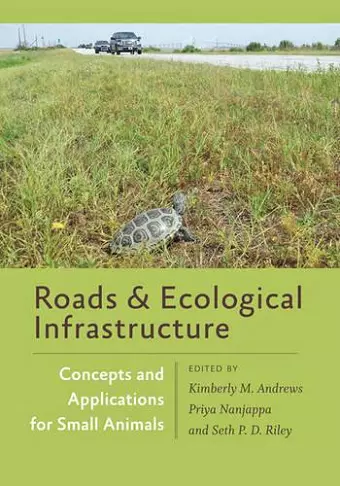Roads and Ecological Infrastructure
Concepts and Applications for Small Animals
Seth P D Riley editor Kimberly M Andrews editor Priya Nanjappa editor
Format:Hardback
Publisher:Johns Hopkins University Press
Published:9th Jun '15
Currently unavailable, and unfortunately no date known when it will be back

This book addresses the impact of roads on small wildlife, offering solutions for reducing fatalities and promoting habitat connectivity in future road design.
In Roads and Ecological Infrastructure, the critical relationship between roadways and wildlife is explored in depth. The book addresses the often-overlooked consequences that roads have on small animal populations, particularly those that are slow-moving or have specific habitat needs. It poses important questions about the survival of species like turtles and salamanders, who face perilous journeys across busy highways and roads, threatening their reproductive success and overall survival. The presence of roads creates barriers that can divide populations, disrupt migration patterns, and lead to tragic fatalities, underscoring the urgent need for innovative solutions.
The authors of Roads and Ecological Infrastructure come from diverse backgrounds, including transportation engineering and ecological research, bringing a wealth of knowledge to the table. They emphasize the importance of understanding animal behavior in relation to road design, offering insights into how transportation infrastructure can be modified to minimize its negative effects on wildlife. The book provides a comprehensive overview of habitat connectivity and presents practical strategies for creating safer roadways that consider the needs of small animal species.
By synthesizing research and practical recommendations, Roads and Ecological Infrastructure aims to influence future road design in ecologically sensitive areas. It serves as a vital resource for conservationists, transportation planners, and policymakers, advocating for a collaborative approach to mitigate the impacts of roads on vulnerable wildlife populations. The insights offered in this book are essential for fostering a balance between development and the preservation of our natural ecosystems.
Road kills seriously affect some animal populations, and this book should be required reading for high school and college students, faculty, and general readers. CHOICE Reviews A primary goal of the editors is to broaden the reader's view of road impacts on small animals by providing the ecological context within which the public infrastructure (roads, bridges, etc.) functions... The book is a call to action for researchers, engineers, landscape planners, and others involved with road ecology to collaborate... to reach common goals. Herpetological Review University researchers, government agencies involved in transportation issues, land managers, conservation biologists, and anyone concerned with the losses to herpetofauna and small mammals because of roads will find this volume to be an important and insightful resource. Quarterly Review of Biology
ISBN: 9781421416397
Dimensions: 254mm x 178mm x 24mm
Weight: 794g
304 pages